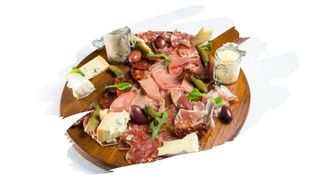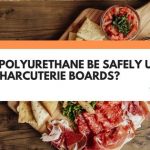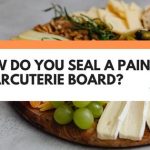There aren’t very many wood finishes that are safe enough to come into direct contact with food. In fact, the term ‘food safe’ finish is probably one of the most misunderstood definitions in finishing.
Yet, when it comes to food safety, understanding what this term really means is incredibly important.
RELATED POST: 4 Reasons Why You Should NOT Use Polyurethane On A Butcher Block
So, in this post, you’ll learn why a food grade finish is the safest and best finish for a charcuterie board. You will also learn why food safe finishes, (such as polyurethane), should not have direct contact with food.
And keep reading to discover which two food grade wood finishes are ideal for your wooden board.

This post may contain affiliate links to products that we receive a commission for (at no additional cost to you). Learn more here.
What’s The Best Finish For A Charcuterie Board?
Well, charcuterie boards are generally used to serve up meats, cheeses, and other appetizers. So, any finish you use on this board is going to have direct contact with food.
This is why the best type of finish you can use on a charcuterie board is a ‘food grade’ finish.
Food grade finishes are non-toxic. In fact, they are so non-toxic that they are even safe for human consumption.
Which is why if a little bit of a food grade finish gets into a piece of meat, you needn’t worry.
Great! So What Is The Best Food Grade Wood Finish For A Charcuterie Board?
Your best (and most practical) option is to simply get some 100% pure food grade mineral oil.
Mineral oil is a non-drying oil that’ll soak right down into a wooden surface, coating wood fibers. This oil doesn’t wash off, so it stays on those fibers, stopping them from absorbing moisture.
However, mineral oil isn’t a durable wood finish.
As a non-drying oil, mineral oil does not dry, cure or harden into a solid resin coat (like say Tung oil). That is why you will need to reapply this finish fairly often (depending on how frequently you wash that board).
RELATED POST: Is Polycrylic Food Safe (And Waterproof) Enough For Your Kitchen Table?
What Is Mineral Oil? Is It Really That Safe?
Mineral oil is made from distilled petroleum. But this oil has been so heavily refined that it is wholly non-toxic. You can find it on the shelves of your local pharmacy, (typically sold as a laxative), or in most groceries stores.
This oil doesn’t go bad, (unlike culinary oils such as sunflower oil or vegetable oil). So, you can freely saturate your charcuterie board without worrying about this oil becoming rancid.
Is There An Alternative To Using Mineral Oil? What Other Finish Can I Use Instead?
If you don’t like the thought of petroleum soaking your charcuterie board, (even if it is refined), then you can use fractionated coconut oil.
This oil is made from coconut oil, except for the fact that this oil has been filtered of fatty acids.
You see, those fatty acids are the reason why regular culinary coconut oil can go rancid. But once you separate those acids out, you are left with a fairly watery odorless non-drying oil that you can use as a finish.
Fractionated oil tends to cost a little bit more than mineral oil, but it’ll work just as well.
What About Polyurethane? Can I Use Polyurethane On A Charcuterie Board Too?
Well, polyurethane (after it has dried and cured) is a food safe wood finish.
What this means is that it is safe for indirect contact with food. It is not safe for direct contact with food — especially if you may end up nicking and scratching bits of this finish with a cheese knife.
RELATED POST: Can Polyurethane Be Safely Used On Charcuterie Boards?
The only type of wood finish you can truly safely use on a charcuterie board is a food grade one, like mineral oil or fractionated coconut oil.
Think of it like this: a food safe wood finish can be used on a wooden dinner table (indirect food contact). But, a food grade finish can be used on a wooden cooking spoon (direct food contact).
To Wrap Up, Here Are The 3 Key Takeaways From This Post…
- 1). The best type of wood finish for a charcuterie board is a food grade wood finish. These finishes are non-toxic and safe for human consumption. So it’s perfectly fine if they come into direct contact with your food.
- 2). The best and most reliable food grade wood finish is 100% pure food grade mineral oil. This non-drying oil is made from heavily refined petroleum distillate.
- 3). Alternatively, you can use fractionated coconut oil to finish a charcuterie board. This watery filtered coconut oil does not go rancid. And it’ll work just as well as mineral oil when it comes to sealing wooden kitchen utensils.


